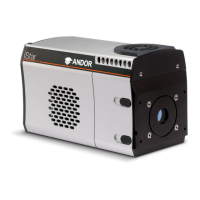Appendix
SATURATION
Saturation is the largest signal a CCD can measure. A signal is measured in terms of the amount of charge that has built
up in the individual pixels on the CCD-sensor. A number of factors determine the maximum amount of charge that the
CCD can handle.
Each pixel is ultimately limited in the amount of charge it can hold (its “well depth”), in other words, is nite. This
maximum charge, or well depth, is generally quoted in electrons. The well depth of a single pixel in the CCD detector is
typically in the order of 300,000 electrons, but is ultimately dependant on the sensor.
SCAN TYPES: KEEP CLEAN & ACQUIRED
The CCD is continually being “scanned” to keep it maintained in a “ready state”. If the Scan is being used simply to
“clean” the CCD (i.e. it is a keep-clean scan), the charge from the CCD is discarded.
In an acquired scan, however, the charge undergoes A/D conversion and is acquired into computer memory so that
it can be used for subsequent processing and display: it is “read out” (see Readout previously). In this User’s Guide
“scan” generally refers to an acquired scan - unless the context specically indicates otherwise.
SHIFT REGISTER
The Shift Register usually consists of a single row of elements (or pixels) running parallel to and below the bottom row
of light-gathering pixels (the image area) on the CCD-sensor. The shift register is protected from light by an aluminum
mask. The elements in the shift register have a greater capacity to store charge (a greater ‘well depth’) than the other
pixels on the CCD-sensor.
SHOT NOISE
Shot Noise is due to basic physical laws and cannot be removed. Any signal, whether it be a dark signal or a light signal,
will have shot noise associated with it. Most simply dened:
•Ifthesignalordark signal = N electrons, the shot noise is the square root of N.
You can do nothing about the shot noise of your signal, but by choosing minimum exposures and operating the CCD at
suitably low temperatures, the dark signal, and hence the noise from the dark signal, can be reduced.
SIGNAL TO NOISE RATIO
The Signal to Noise Ratio (S/N) is the ratio between a given signal and the noise associated with that signal. Noise has a
xed component, and a variable component (shot noise) which is the square root of the signal. Thus, the Signal to Noise
Ratio usually increases (improves) as the signal increases.
The maximum Signal to Noise Ratio is the ratio between the maximum signal (i.e. the saturation level) and the noise
associated with that signal. At near saturation levels the dominant source of noise is the shot noise of the signal.

